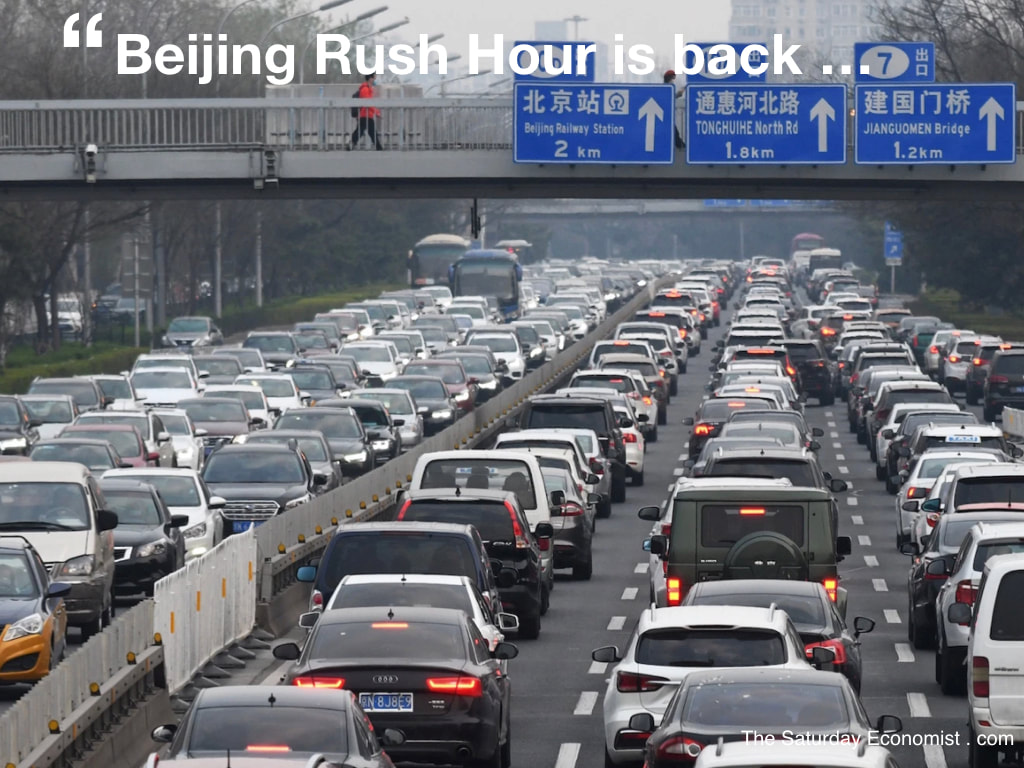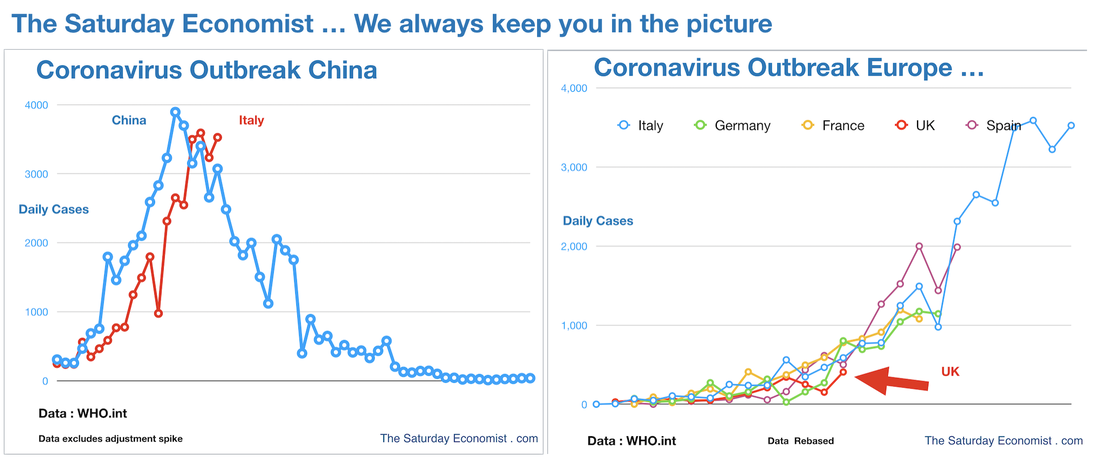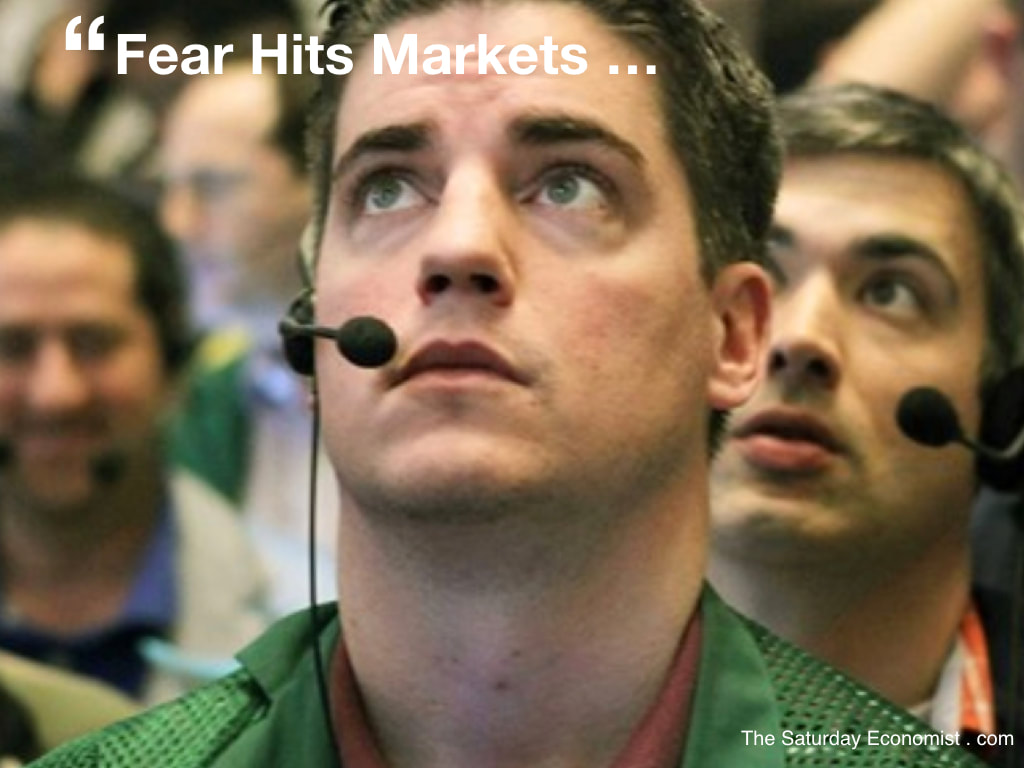|
In Beijing the rush hour is back. Travel restrictions are being removed. Life is slowly returning to normal. No new cases have been reported on the mainland for over a week now.
The government is urging a swift return to normal. Businesses are urged to use smart technologies to accelerate the process. Over 70% of small and medium size businesses are now back in action. Smaller businesses struggle to meet local authority regulations in place to control the virus. Distance working, within units, can pose problems, the supply of face masks is a further inhibiting factor. Remote working and smart manufacturing platforms are encouraged as part of the process. China is well set to facilitate the change. China's cloud infrastructure has grown rapidly over the past few years. The market grew by almost 70% in the final quarter of 2019, with a value of $US 3.3 billion. Alibaba Cloud accounts for 47% of the market, followed by Tencent Cloud and Baidu's AI cloud. Despite the economic shock of the viral outbreak, the acceleration of of cloud, will be one of the beneficiaries of the change in working habits likely to result. Despite the recovery from the viral outbreak, China faces the problem of a second economic wave as markets in the West face lock down. Output may have fallen by 10% in the first quarter. Further setbacks are expected in the second quarter. Forecasts for growth in the year have been reduced from 6.1% to 2.6% by CICC. Despite an expected bounce back in consumer spending and investment, exports may fall by as much as 20% as world demand slows. China's recovery offers hope to the West and should be a model for recovery. As expected the Italian daily case load topped out last week. Despite the higher number reported yesterday, our momentum model suggests the downturn will continue. Spain is now reporting higher numbers but should peak within days. The UK is set to enter the "eye of the storm", the numbers will accelerate in the week ahead. In the U.S. Trump is suggesting it could all be over by Easter. Our viral model suggests the end of May, early June, is more likely ... Rumours of Our Deaths Greatly Exaggerated ... The good news, rumours of our deaths are greatly exaggerated. According to the latest research from Imperial College, The lock down has been so successful, Britain is now on course for an estimated 5,700 deaths from Covid-19. "Our work shows that social distancing is working" said Tom Pike. Neil Ferguson, Professor Pike's colleague at Imperial college, presented a model analysis suggesting the virus would kill 260,000 people, had Britain maintained a less restrictive policy. "Left unchecked altogether, the death rate could have been as high as 510,000" he added. The 510,000 number, assumed an 80% infection rate. That's far higher than the Spanish Flu of 1918 and the experience of crew and passengers of the Diamond Princess in 2020. Both around 20% were higher than the reported infection rate in Wuhan province of around 1in1000. So should we take comfort from the latest volte face from Imperial? Of course. Wuhan province reported just over 3,000 deaths from almost 70,000 cases in a population of 60 million people. Pro rata the UK case load would be around 90,000 with a projected loss of life of less than 5,000. The adjusted rate would be almost 1% lower as many would die of natural causes. Bit gloomy this for a Saturday? I hope not. Numbers in the UK are set to accelerate over the next week. We expect the case load to peak within the next ten days. The viral episode should be over by the end of May. Social distancing measures should be easing by the end of April. The virus is behaving as expected, the strike on Downing Street, just part of the process. For most businesses, the focus is on cash and survival over the next few months. As with all things, this too will pass, sooner than many expect. Then comes the sunshine and the opportunity to benefit from the strong recovery expected. Fears of a second great depression, as with rumours of our deaths are greatly exaggerated ... That's all for this week. Have a great, safe, week-end, wash your hands and don't talk to strangers, Watch the numbers not the headlines, John
0 Comments
Thumbs up in Wuhan. The Checkpoints are taken down, travel restrictions are eased. The city hardest hit by the epidemic is slowly returning back to normal. Elsewhere in the country, other cities have been easing control measures. China has reported no new domestic cases for three days now.
The China viral episode is marked as a twelve week cycle, a perfectly "normal" pattern of viral distribution. The critical phase, the six week "quarantina" phase lasts six weeks. 95% of cases, (within two standard deviations of the norm), occur in this critical phase. Should we be surprised by this? Not really. Quarantina is the Venetian word for forty days. Forty days was the period of isolation for new ships arriving at port in the 14th century. Michael Levitt, the British American Israeli biophysicist, predicted the epidemic would disappear from China by the end of March. The Nobel prize for chemistry was the scientist's prize in 2013. His speciality is not epidemiology nor virology. For Michael Levitt, modelling the viral epidemic is a numbers game and a pretty simple numbers game at that. Levitt explains, "In exponential growth models, you assume that new people will be affected every day because you meet new people. But most of us meet the same people every day. You may meet new people on the bus or in public places but gradually most people will be infected or immune". To stem the epidemic, in the absence of vaccine, the virus must be starved of victims to limit the outbreak. The government may claim we have moved from the containment phase to the delay phase but this is not correct. Home isolation and social distancing are measures to contain the virus, there can be no delay. The viral episode self extincts. Neither can we flatten the curve. We can lower the peak of the outbreak by imposing radical social distancing measures and other "non pharmaceutical interventions". A viral spread is a mathematical function with three critical ratios, the infection rate, the reproduction ratio R(0) and the fatality rate. Assuming an R(2) ratio, ie patient zero infects two people, then 2 people infect 4 people and so on, in a population of 100 people, the virus runs out of victims after just five steps. Then the case load falls, just as dramatically as it has risen. In our C19 tracker we analyze the daily situation reports published by the World Health Organisation. Italy recorded over 5,000 cases yesterday. We are anxiously waiting for the tide to turn. The next few days will be critical. For Korea and Iran, along with China, it would appear the worst is over. In the UK,. the numbers will escalate rapidly in the days ahead. Further social distancing measures may be announced. It is important to watch the data to call the move. The worst could be over by the end of April, the all clear sirens may be heard by the beginning of June ... Our people must be told there will be an end to this ... Cometh the Hour ... Boris Johnson shut down the pubs, restaurants and clubs this week. We were all asked to self isolate in the case of infection. People over seventy were advised to stay indoors. The government is shutting down the leisure, travel and hospitality sectors in a bold measure to protect the population. The measures to deal with a plague or viral epidemic have not changed much since medieval times and beyond. Left untreated the economy could return to the dark ages. Cometh the hour, Cometh the man. The Chancellor announced his bold budget on the 11th March. It all seemed so irrelevant within the week. Fears that millions of jobs could be lost, prompted the most radical intervention to stem redundancies and layoffs. Payment of wages, Cash injections, VAT holidays, Interest Free Loans, Welfare Measures, an increase in universal credit, support for renters and much more. We are set to part nationalize the airlines and airport business along with the rest of the transport sector, The Treasury did not put a figure on the size of the bail out. The option to watch the economy lapse into free fall would have been too expensive with no prospect of a rapid recovery. Economists are forecasting recession. Borrowing is set to increase above the £160 billion in 2009/10. The bank has cut rates twice to ease the funding cost. The markets reacted by pushing up ten year gilt rates. Where will the money come from? More QE. The Treasury will fund the deficit. The Debt Management Office will issue the debt. The Bank of England will buy the debt, underwritten by the Treasury. The interest payments will be returned to the Treasury. They are guaranteeing the debt after all. So we are stuck on planet ZIRP with a plague on our financial houses. We cannot predict the impact on markets and economies until we have marked the path of the C19 virus. We will publish our regular C10 tracker updates, watch this space. We plan a series of webinars at the end of April. For the moment, stay safe, wash those hands and watch the data. Above all stay in touch. That's all for this week. Have a great, safe, week-end. Turning the tide in 12 weeks, is this what the Prime Minister is talking about ...
1 The "China syndrome" offers a classic viral "model". 2 We can assign a “90 day window” for the episode. 3 95% of the cases (2 standard deviations) occur in the critical six week window. 40 days to be exact. This is the old Venetian 14th Century “Quarantina” period for foreign ship isolation. 4 Europe is tracking the China Syndrome at the moment. (We really need to see the turn in Italian data in the next few days to confirm the hypothesis. 5 Our guidelines are … (Base case and Best Case Scenario) 5.1 Plan for a 90 day window. The UK is tracking two weeks behind Italy and one week behind Germany. 5.2 We are now (UK) in the “Quarantina" Peak Period. There will be dramatic increases in infections in the next two weeks. 5.3 We could see “Mandatory House Confinement” shortly in parts of the UK. 5.4 The critical phase could be drawing to a close by the end of April. (Possible end of MHC). 5.5 The return to normal could begin towards the end of May. Let's hope this is how things work out. Stay safe, Wash those hands, John The Saturday Economist ... we always keep you in the picture Flatten your sombreros and wait for the sunshine, appears to be the key advice from Government in the midst of the Coronavirus crisis. The government model assumes a 60% infection rate is necessary to guarantee herd immunity.
With a population of 67 million, 40 million will be infected. Three million critical cases, will overload the 160,000 NHS beds available. With a 1% fatality rate, the death carts will be rolling down the streets of Britain. The cry of "Bring out Your Dead" would lead to 400,000 bodies, piled into emergency graves around the country. Boris Johnson warned this week, we should prepare to lose more of our loved ones. Some thought this was a hint of another cabinet reshuffle, others the Number Ten Dog, called Dilyn was to be returned to the dogs home. It's a Jack Russell Cross, apparently, well, it certainly wasn't very pleased. It was left to the PM's fiancée, Carrie Symonds to assure dog lovers everywhere, the mutt was staying put. To avoid a crisis in the health service, the government plan is to flatten the curve. We are moving from the "contain" phase to the "delay phase". The "contain" phase obviously didn't go to well, not much hope for the delay phase either. Hope is for the sunshine and UV rays to inhibit or kill the virus as the warm weather arrives. So what can we really expect? The evidence from China suggests the covid-19 epidemic operates within a six week cycle. 40 days is the classic viral curve. The word "quarantine" is derived from the Italian "Quarantina", "Quaranta Giorni", or forty days. In the 14th century, ships arriving in Venice, were required to sit at anchor for 40 days before disembarking. The Venetians had learned from experience. So much for flattening the curve. Statistically the reproduction ratio R(0) of the virus is 2.3. Within 21 basic steps, the virus will impact a population of 90 million. In China just 11 new cases were reported yesterday. In Hubei province, a population of some 59 million, a total of 68,000 cases have been reported and 3,062 deaths have been recorded. The infection rate is just over 1.1% of the population. The mortality rate is 4.5%. The adjusted mortality rate is 3.7%. In Korea, 250,000 people have been tested. In a population of 51 million, just 8,000 cases have been identified. 66 deaths have been reported. The mortality rate is 0.8%. In the U.K. so far 1,144, cases have been reported, with 21 deaths recorded. Worse is yet to come, assuming the China syndrome unfolds. The number of cases in the UK could rise to over 75,000 with 3,500 deaths involved. For many this will be a great discomfort and tragedy. For the UK as a whole, Government reports of our potential deaths appear to be greatly exaggerated ... President Xi visits Wuhan ... In China, President Xi made a visit to Wuhan. The emergency hospitals built in just ten days, have closed, the epidemic appears to have passed. Hailing "Victory to Wuhan" and saluting the people as "heroes", the President used his first trip to the province since the outbreak, to signal that China had turned the tide in the battle against the deadly disease. The message to the domestic audience is the "Rampant Epidemic" has now been brought under control. This has been possible, only under the leadership of people's hero Xi. "It is time for businesses and factories to return to normal" and for the country to refocus on economic growth. Foxconn founder Terry Gou, reported this week, supplies to plants in China and Vietnam have returned to normal. Resumption of production in mainland China, had exceeded expectations following the disruption from the coronavirus outbreak. The company warned revenue would drop by 15% in the first quarter. Output will return to normal but fears persist for the level of demand in China in the short term and sales in Europe and North America into the summer months. For good measure the Chinese government confirmed plans to build 215 new airports over the next fifteen years. Fourteen new airports each year will be built. China's aviation industry will become a key part of the economy of the soon to be largest economy in the world. In the US the President's statements on the outbreak merely added to the confusion and chaos. The National Guard were called into New York. A National Emergency was declared, merely adding to the growing sense of panic. That's all for this edition. We will be back with more news and analysis, as we look at the impact of the budgets and market developments over the past week. Stock markets came under further pressure this week. European stocks closed lower. The FTSE ended the week at 6,463, the lowest level since June 2016.
In the US, markets fared better. The Dow closed up on the week 250 points at 25,400. The S&P and NASDAQ held firm. Sentiment had been badly hit by reduced forecasts for world growth from the OECD and the IMF. The Coronavirus could "halve global growth", according to the Organisation for Economic Growth and Development. "Covid-19 presents the greatest danger to the world economy since the financial crisis of 2008" it said. The IMF warned the spread of the disease would push growth below the levels of last year. The IMF is to offer a $50 billion dollar emergency fund for countries hit by the virus. In the OECD's base case scenario, a short lived outbreak, would suggest global growth would slow to 2.4% this year from a previous estimate of 2.9%. In China, growth is expected to fall to 5% this year, from 6.1% last year. Eurozone growth could fall below 1%, a similar scenario, would develop in the UK. A longer lasting and more intensive outbreak, spreading through Asia-Pacific, Europe and North America could cut growth to 1.5%, the OECD claimed. So what's the outlook ...? The number of cases of Coronavirus is set to hit over 100,000 this weekend. The good news ... data from the World Health Organisation suggests the crisis has passed in China. The number of cases has dropped to 140 per day compared to 4,000 at peak. The data suggests a 12 - 13 week cycle for the outbreak with a 1% infection rate and a 3.7% adjusted mortality rate. [See our "Say Goodbye to the God of Plague" Chart Update below] 60 million people in the Hubei confined zone presented 68,000 cases and resulted in just over 3,000 deaths. The adjusted mortality rate is less than 4%. Higher than flu perhaps but with a much lower infection rate per 000 of population. Cases outside of China are highest in South Korea, Italy and Iran. The next week's data will be critical in determining the pattern of expansion. In China, the economy is slowly returning to normal, assuming no secondary wave appears. In the UK we are moving into the "delay phase". If only we could move winter flu into the warmer summer months. Advice appears to be wash your hands regularly and rinse your mouth with alcohol, preferably vodka. "Nothing to fear but fear itself" was Roosevelt's warning ahead of the Great Recession. Analysis of the data from China would help ... Fed Slashes Rates ... In the US the Fed slashed rates by 50 basis points this week. The move planned to ease the crisis in the U.S.A. With just 150 cases reported by the weekend, the Central Bank appears to be moving well ahead of the curve. Pressure from the White House may have pushed the move. The President was urging action to cut rates in view of the threat of Covid-19. The "Democratic Hoax" Trump claims, assisted his monetary agenda. For Trump, The 50 basis points is not enough. A further cut would be preferable as zero or negative rates loom. US ten year bond yields fell to 0.7%. Life on Planet ZIRP just became a little weirder. "The Fed is panicking", claimed Bond King Jeffrey Gundlach. "Once the Fed does a panic cut between meetings, a further cut is likely to follow". "Short rates are headed to zero with a further cut now possible when the Fed meets later this month" the claim. And yet it was all going so well. The American economy was accelerating, at least since the outbreak began to spook markets. Non farm payrolls increased by 273,000 in February. The number was well ahead of the 175,000 expected. The data for previous months was revised up, bringing the three month average to 254,000 jobs. The unemployment rate fell to 3.5%. Earnings increased by 3%. The U.S. economy is set to grow by over 2% this year. It is a strange time to slash base rates and push long rates lower. Markets are unconvinced by the move. Traders have little faith in the ability of central banks to protect economies from disruption. No wonder as travel plans are hit and consumers ease back on spending. The travel and leisure sectors badly hit. Uncertainty on how far the coronavirus will spread and the impact it will have on the economy is pushing the move away from equities. Gold prices moved higher closing at $1,667. Oil prices Brent Crude moved lower, closing below $46 dollars per barrel. Hand Gel prices on Amazon have reached an all time high ... Economic Data Bounces ... In the U.K., the latest PMI data suggests manufacturing activity is increasing, despite some concerns about supply chain disruption. Construction activity increased in February. The composite index jumped to 52.6 in February compared to 48.4 prior month. Renewed momentum in the housing market, has led to an increase in housing starts. Companies reported the strongest rise in new orders since December 2015. The service sector recorded a further increase in business activity in February, albeit down slightly from the high levels recorded prior month. The rate of expansion slowed as the shadow of the coronavirus loomed. Bookings and delays to new projects in Asia featured in the slow down apparently. Business confidence remains high. Political uncertainty has been eliminated for now. Brexit challenges remain. Problems with recruitment and immigration will persist. It will be interesting to see what the new Chancellor has in the Red Box next week. Delays to infrastructure spending may well feature ... as the fears for the economy develop. That's all for this week, have a great weekend. We will be back with more news and updates next week. |
The Saturday EconomistAuthorJohn Ashcroft publishes the Saturday Economist. Join the mailing list for updates on the UK and World Economy. Archives
July 2024
Categories
All
|
| The Saturday Economist |
The material is based upon information which we consider to be reliable but we do not represent that it is accurate or complete and it should not be relied upon as such. We accept no liability for errors, or omissions of opinion or fact. In particular, no reliance should be placed on the comments on trends in financial markets. The presentation should not be construed as the giving of investment advice.
|
The Saturday Economist, weekly updates on the UK economy.
Sign Up Now! Stay Up To Date! | Privacy Policy | Terms and Conditions | |





 RSS Feed
RSS Feed